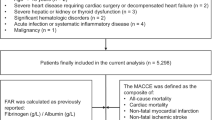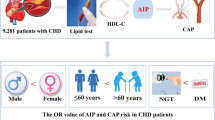Abstract
Aim
The relationship between fibrinogen/albumin ratio (FAR) and carotid artery plaques (CAPs) was investigated in patients with coronary heart disease (CHD).
Methods
A total of 11,624 patients with CHD were enrolled and divided into quartiles based on the FAR (Q1: FAR index ≤ 0.0663; Q2: 0.0664 ≤ FAR index ≤ 0.0790; Q3: 0.0791 ≤ FAR index ≤ 0.0944; Q4: FAR index > 0.0944). Patients were classified into three groups according to their blood glucose levels: normal glucose regulation (NGR), prediabetes mellitus (pre-DM), and diabetes mellitus (DM) groups. Carotid ultrasonography was performed to detect CAPs. The relationship between FAR and CAPs was evaluated using logistic and subgroup analyses.
Results
Among 11,624 participants, 8738 (75.14%) had CAPs. Compared with Q1, the odds ratio (OR) of Q4 in patients with CHD was 2.00 (95% confidence interval [CI]: 1.71–2.34) after multivariate adjustment. Taking Q1 as a reference, a higher OR was observed in Q4 of FAR for CAPs in men [OR: 2.26; 95% CI: 1.73–2.95] in the multi-adjusted models. Moreover, multivariate adjustment indicated that the highest OR was observed in patients with CHD and DM (OR: 2.36; 95% CI: 1.80–3.10).
Conclusions
A significant association between FAR and CAPs was observed in patients with CHD, regardless of sex or blood glucose levels. Therefore, FAR may be used as an effective indicator to identify patients at a high risk of CAPs among patients with CHD.

Similar content being viewed by others
Abbreviations
- FAR:
-
Fibrinogen/albumin ratio
- CHD:
-
Coronary heart disease
- CAPs:
-
Carotid artery plaques
- NLR:
-
Neutrophil/lymphocyte ratio
- PLR:
-
Platelet/lymphocyte ratio
- LMR:
-
Lymphocyte/monocyte ratio
- BMI:
-
Body mass index
- DM:
-
Diabetes mellitus
- HbA1c:
-
Glycated hemoglobin
- FIB:
-
Fibrinogen
- ALB:
-
Albumin
- FPG:
-
Fasting plasma glucose
- LDL-C:
-
Low-density lipoprotein cholesterol
- TG:
-
Triglycerides
- HDL-C:
-
High-density lipoprotein cholesterol
- TC:
-
Total cholesterol
- NGR:
-
Normal glucose regulation
- Pre-DM:
-
prediabetes mellitus
- SBP:
-
Systolic blood pressure
- DBP:
-
Diastolic blood pressure
- IMT:
-
Intima-media thickness
- OR:
-
Odds ratio
- CI:
-
Confidence interval
- IQR:
-
Interquartile range
- MACE:
-
Major adverse cardiovascular events
References
P. Libby, Inflammation in atherosclerosis—no longer a theory. Clin. Chem. 67(1), 131–142 (2021). https://doi.org/10.1093/clinchem/hvaa275
O.P. Akinyelure, L.D. Colantonio, N.S. Chaudhary et al. Inflammation biomarkers and incident coronary heart disease: the reasons for geographic and racial differences in stroke study. Am. Heart J. 253(undefined), 39–47 (2022). https://doi.org/10.1016/j.ahj.2022.07.001
Y. Liu, Z. Li, X. Wang et al. Effects of adjuvant Chinese patent medicine therapy on major adverse cardiovascular events in patients with coronary heart disease angina pectoris: a population-based retrospective cohort study. Acupunct. Herb. Med 2(2), 110–118 (2022). https://doi.org/10.1097/HM9.0000000000000028
N. Puig, P. Camps-Renom, M. Camacho et al. Plasma sICAM-1 as a biomarker of carotid plaque inflammation in patients with a recent ischemic stroke. Translational Stroke Research, 1–12 (2022). https://doi.org/10.1007/s12975-022-01002-x
W.B. Horton, E.J. Barrett, Microvascular dysfunction in diabetes mellitus and cardiometabolic disease. Endocr. Rev. 42(Jan 1), 29–55 (2021). https://doi.org/10.1210/endrev/bnaa025
X. Cheng, Z. Li, M. Yang, Y. Liu, S. Wang et al. Association of HbA1c with carotid artery plaques in patients with coronary heart disease: a retrospective clinical study. Acta Cardiologica, 1–9 (2022). https://doi.org/10.1080/00015385.2022.2040822
C. Chen, C. Lu, W. Liu et al. Association between fibrinogen/albumin ratio and arterial stiffness in patients with type 2 diabetes: a cross-sectional study. Front. Pharmacol. 13, 1120043 (2023). https://doi.org/10.3389/fphar.2022.1120043
L. Fu, Z. Liu, Y. Liu, Fibrinogen-like protein 2 in inflammatory diseases: a future therapeutic target. Int. Immunopharmacol. 116, 109799 (2023). https://doi.org/10.1016/j.intimp.2023.109799
C.T. Hsieh, K.L. Chien, H.C. Hsu et al. Associations between fibrinogen levels and the risk of cardiovascular disease and all-cause death: a cohort study from the Chin-Shan community in Taiwan. BMJ Open 12(4), e054638 (2022). https://doi.org/10.1136/bmjopen-2021-054638
D. Yuan, P. Jiang, P. Zhu et al. Prognostic value of fibrinogen in patients with coronary artery disease and prediabetes or diabetes following percutaneous coronary intervention: 5-year findings from a large cohort study. Cardiovasc. Diabetol. 20(1), 1–13 (2021). https://doi.org/10.1186/s12933-021-01335-1
G.J. Quinlan, G.S. Martin, T.W. Evans, Albumin: biochemical properties and therapeutic potential. Hepatology 41(6), 1211–1219 (2005). https://doi.org/10.1002/hep.20720
Y.Y. Zheng, T.T. Wu, Y. Chen et al. Gamma‐glutamyl transferase to albumin ratio as a novel predictor of bleeding events and mortality in patients after percutaneous coronary intervention: a retrospective cohort study. Catheter. Cardiovasc. Interven. 95, 572–578 (2020). https://doi.org/10.1002/ccd.28696
Z. Duan, C. Luo, B. Fu et al. Association between fibrinogen-to-albumin ratio and the presence and severity of coronary artery disease in patients with acute coronary syndrome. BMC Cardiovasc. Disord. 21(1), 1–10 (2021). https://doi.org/10.1186/s12872-021-02400-z
M. Li, C. Tang, E. Luo et al. Relation of fibrinogen-to-albumin ratio to severity of coronary artery disease and long-term prognosis in patients with non-ST elevation acute coronary syndrome. BioMed Res. Int. 2020 (2020). https://doi.org/10.1155/2020/1860268
B. Deveci, E. Gazi, Relation between globulin, fibrinogen, and albumin with the presence and severity of coronary artery disease. Angiology 72(2), 174–180 (2021). https://doi.org/10.1177/0003319720959985
P. Wang, D. Yuan, C. Zhang et al. High fibrinogen-to-albumin ratio with type 2 diabetes mellitus is associated with poor prognosis in patients undergoing percutaneous coronary intervention: 5-year findings from a large cohort. Cardiovasc. Diabetol. 21(1), 1–13 (2022). https://doi.org/10.1186/s12933-022-01477-w
T. Corriere, S. Di Marca, E. Cataudella et al. Neutrophil-to-Lymphocyte ratio is a strong predictor of atherosclerotic carotid plaques in older adults. Nutr. Metab. Cardiovasc. Dis. 28(1), 23–27 (2018). https://doi.org/10.1016/j.numecd.2017.10.022
X. Li, J. Li, G. Wu, Relationship of neutrophil-to-lymphocyte ratio with carotid plaque vulnerability and occurrence of vulnerable carotid plaque in patients with acute ischemic stroke. BioMed Res. Int. 2021 (2021). https://doi.org/10.1155/2021/6894623
C. Varım, P. Varım, B.A. Acar et al. Usefulness of the platelet-to-lymphocyte ratio in predicting the severity of carotid artery stenosis in patients undergoing carotid angiography. Kaohsiung J. Med. Sci. 32(2), 86–90 (2016). https://doi.org/10.1016/j.kjms.2015.12.007
A. Bolayir, E. Bolayir, Can lymphocyte to monocyte ratio be used as a predictor of atherosclerotic carotid plaques in elderly adults? Cumhur. Med. J. 40(2), 120–127 (2018). https://doi.org/10.7197/223.v40i37154.406575
Y. Liu, M. Ma, L. Li et al. Association between sensitivity to thyroid hormones and dyslipidemia in patients with coronary heart disease. Endocrine 79(3), 459–468 (2023). https://doi.org/10.1007/s12020-022-03254-x
S.Y. Kim, The definition of obesity[J]. Korean J. Fam. Med. 37(6), 309–309 (2016). https://doi.org/10.4082/kjfm.2016.37.6.309
American Diabetes Association, Standards of medical care in diabetes–2013. Diabetes Care 36(Suppl 1), S11–S66 (2013). https://doi.org/10.2337/dc13-s011
F. Mach, C. Baigent, A.L. Catapano et al. ESC Scientific Document Group. 2019 ESC/EAS Guidelines for the management of dyslipidaemias: lipid modification to reduce cardiovascular risk. Atherosclerosis 290, 140–205 (2020). https://doi.org/10.1016/j.atherosclerosis.2019.08.014
B. Williams, G. Mancia, W. Spiering et al. 2018 ESC/ESH Guidelines for the management of arterial hypertension: the task force for the management of arterial hypertension of the European Society of Cardiology (ESC) and the European Society of Hypertension (ESH). Eur. Heart J. 39(33), 3021–3104 (2018). https://doi.org/10.1714/3026.30245
J.H. Stein, C.E. Korcarz, R.T. Hurst et al. American Society of Echocardiography Carotid intima-media thickness task force. Use of carotid ultrasound to identify subclinical vascular disease and evaluate cardiovascular disease risk: a consensus statement from the American Society of Echocardiography Carotid intima-media thickness task force. Endorsed by the society for vascular medicine. J. Am. Soc. Echocardiogr. 21(2), 93–111 (2008). https://doi.org/10.1016/j.echo.2007.11.011
Z. Li, Y. He, S. Wang et al. Association between triglyceride glucose index and carotid artery plaque in different glucose metabolic states in patients with coronary heart disease: a RCSCD-TCM study in China. Cardiovasc. Diabetol. 21(1), 1–11 (2022). https://doi.org/10.1186/s12933-022-01470-3
W. Zhang, L. Liu, H. Chen et al. Association between the triglyceride-glucose index and the presence and prognosis of coronary microvascular dysfunction in patients with chronic coronary syndrome. Cardiovasc. Diabetol. 22(1), 1–13 (2023). https://doi.org/10.1186/s12933-023-01846-z
L. Song, X. Zhao, R. Chen et al. Association of PCSK9 with inflammation and platelet activation markers and recurrent cardiovascular risks in STEMI patients undergoing primary PCI with or without diabetes. Cardiovasc. Diabetol. 21(1), 1–13 (2022). https://doi.org/10.1186/s12933-022-01519-3
L. Gago, M. del Mar Vila, M. Grau et al. An end-to-end framework for intima media measurement and atherosclerotic plaque detection in the carotid artery. Comput. Methods Prog. Biomed. 223, 106954 (2022). https://doi.org/10.1016/j.cmpb.2022.106954
L. Fang, F.H. Yan, C. Liu et al. Systemic inflammatory biomarkers, especially fibrinogen to albumin ratio, predict prognosis in patients with pancreatic cancer. Cancer Res. Treat.: Off. J. Korean Cancer Assoc. 53(1), 131–139 (2021). https://doi.org/10.4143/crt.2020.33
B. Li, H. Deng, B. Lei et al. The prognostic value of fibrinogen to albumin ratio in malignant tumor patients: a meta-analysis. Front. Oncol. 12. (2022). https://doi.org/10.3389/fonc.2022.985377
L. Xiao, Y. Jia, X. Wang et al. The impact of preoperative fibrinogen-albumin ratio on mortality in patients with acute ST-segment elevation myocardial infarction undergoing primary percutaneous coronary intervention. Clin. Chim. Acta 493, 8–13 (2019). https://doi.org/10.1016/j.cca.2019.02.018
J.J. Man, J.A. Beckman, I.Z. Jaffe, Sex as a biological variable in atherosclerosis. Circ. Res. 126(9), 1297–1319 (2020). https://doi.org/10.1161/circresaha.120.315930
D.H.K. van Dam-Nolen, N.C.M. van Egmond, K. Dilba et al. Sex differences in plaque composition and morphology among symptomatic patients with mild-to-moderate carotid artery stenosis. Stroke 53(2), 370–378 (2022). https://doi.org/10.1161/strokeaha.121.036564
D.H.K. van Dam-Nolen, N.C.M. van Egmond, P.J. Koudstaal et al. Sex differences in carotid atherosclerosis: a systematic review and meta-analysis. Stroke 54(2), 315–326 (2023). https://doi.org/10.1161/strokeaha.122.041046
R. Huang, Q. Dai, L. Chang et al. The association between fibrinogen-to-albumin ratio (FAR) and adverse prognosis in patients with acute decompensated heart failure at different glucose metabolic states. Cardiovasc. Diabetol. 21(1), 1–13 (2022). https://doi.org/10.1186/s12933-022-01662-x
S.T. Smiley, J.A. King, W.W. Hancock, Fibrinogen stimulates macrophage chemokine secretion through toll-like receptor 4. J. Immunol. 167(5), 2887–2894 (2001). https://doi.org/10.4049/jimmunol.167.5.2887
C.M. Shannon, S.H. Ballew, N. Daya et al. Serum albumin and risks of hospitalization and death: findings from the atherosclerosis risk in communities study. J. Am. Geriatrics Soc. 69(10), 2865–2876 (2021). https://doi.org/10.1111/jgs.17313
E. Hasheminasabgorji, J.C. Jha, Dyslipidemia, diabetes and atherosclerosis: role of inflammation and ROS-redox-sensitive factors. Biomedicines 9(11), 1602 (2021). https://doi.org/10.3390/biomedicines9111602
U.P. Gujral, R. Jagannathan, S. He et al. Association between varying cut-points of intermediate hyperglycemia and risk of mortality, cardiovascular events and chronic kidney disease: a systematic review and meta-analysis. BMJ Open Diabetes Res. Care 9(1), e001776 (2021). https://doi.org/10.1136/bmjdrc-2020-001776
Acknowledgements
We thank all those who participated in the study, the research teams, and the support groups.
Funding
This work was supported by A Cohort Study on Xuefu Zhuyu Cangina pectorissule in the Adjuvant Treatment of Coronary Heart Disease and Angina Pectoris (HX2020-16), the National Natural Science Foundation of China (82074140), the National Natural Science Foundation of China (82104565), and the National Natural Science Foundation of China (82204142).
Author information
Authors and Affiliations
Contributions
X.W., C.Y., and Z.L. participated in the research design and statistical analysis. M.H., M.M., and L.L. compiled the data. R.Y., S.G., Y.H., and Y.L. collected the data. All the authors have read and approved the final manuscript.
Corresponding authors
Ethics declarations
Conflict of interest
The authors declare no competing interests.
Additional information
Publisher’s note Springer Nature remains neutral with regard to jurisdictional claims in published maps and institutional affiliations.
Supplementary information
Rights and permissions
Springer Nature or its licensor (e.g. a society or other partner) holds exclusive rights to this article under a publishing agreement with the author(s) or other rightsholder(s); author self-archiving of the accepted manuscript version of this article is solely governed by the terms of such publishing agreement and applicable law.
About this article
Cite this article
Wang, X., Huang, M., Li, Z. et al. Fibrinogen/albumin ratio and carotid artery plaques in coronary heart disease patients with different glucose metabolic states: a RCSCD-TCM study. Endocrine 84, 100–108 (2024). https://doi.org/10.1007/s12020-023-03558-6
Received:
Accepted:
Published:
Issue Date:
DOI: https://doi.org/10.1007/s12020-023-03558-6




